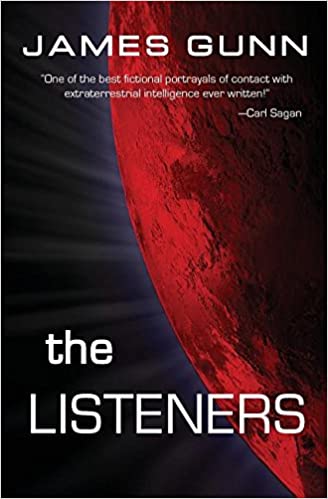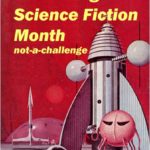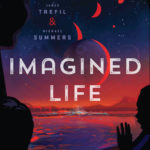Picking out a message among innumerable signals or “voices” is the work of SETI, the search for extraterrestrial intelligence, and it’s the theme of James Gunn’s The Listeners. This is a first contact story from 1972 that Carl Sagan credited as one of the most influential in helping to launch SETI on an international scale. While dated in some obvious ways (it’s a man’s professional world) The Listeners probes the human response to first contact with dramatic and lyrical intensity.

Gunn projected his setting fifty years into the future to 2025-27 when radio astronomers at the Arecibo station in Puerto Rico have been straining to separate signal from noise for almost half a century and have nothing yet to show for their work. They fight fatigue and disillusionment but soldier on under the guidance of their director, Robert MacDonald. a benevolent if flawed man who somehow makes everyone feel inspired about their work.
A signal arrives just as the Project is struggling to retain its funding from Congress. An alien source has wrapped a message amid pop culture radio voices captured from earth. The interpretation of the message poses the question of whether or not to respond as well as how the world will be affected by it. Since the origin of the message is 45 light years away near the star Capella, it will take 90 years to receive a reply to any message sent from earth. That determines the timespan of the story.
Gunn poured a cascade of voices into The Listeners in the form of “Computer runs” with dozens of quotations from real and imagined future scientists, writers, religious figures, politicians and news reports. Interspersed among these runs are chapters capturing critical moments for the Project’s survival.
Each of these scenes relates the interactions of a few key characters as they make crucial decisions about the Project, the message and their own lives. Even though the story of first contact with an alien species is of worldwide significance, Gunn is interested in the human scale impact on the lives of a few key figures:
- Robert MacDonald devotes all his energy to his work, leaving his wife Maria in desperate condition until she attempts suicide. He nearly resigns at that point until the almost mystical draw of the work and his dedicated staff pull him back.
- George Thomas, a skeptical writer determined to “expose” the Project as an exercise in futility, hears the voices, as translated into radio frequencies, like those of the damned in Dante. He is converted to a fervent belief in the Project and becomes its chief PR person.
- Jeremiah, leader of a religious movement (the Solitarians) devoted to the belief that we are alone in the universe, is present when the first contact message is partly interpreted, and he understands it as a message from God.
- Andrew White, first African American President of the United States, who had come to shut down the Project, shifts internally when he hears the final interpretation of the message and is shaken by its implications for the race that sent it. Their star is changing shape, changing brightness, dooming the alien civilization to extinction.
- Robert MacDonald, the elder MacDonald’s estranged son, arrives in 2058 after his father’s death. He is determined to put this phase of his life behind him but is lured into the Project when he hears the signals from the speakers in the office as well as recorded voices of his father and others that help put him in touch with his deepest feelings. Eventually, he becomes the next Project Director.
Gunn infuses the dramatic encounters of most of the characters with a near religious awe as they listen to the radio waves translated into audio frequencies and consider the nature of the work of listening. Here is an early example of the reverential attitude the staff has toward their mission:
When they grew weary at their electronic listening posts, when their eyes grew dim with looking at unrevealing dials and studying uneventful graphs, they could step outside their concrete cells and renew their dull spirits in communion with the giant mechanism they commanded, the silent, sensing instrument on which the smallest packets of energy, the smallest waves of matter, were detected in their headlong, eternal flight across the universe. It was the stethoscope with which they took the pulse of the all and notes the birth and death of stars, the probe with which, here on an insignificant planet of an undistinguished star on the edge of its galaxy, they explored the infinite.
The Listeners, p12, 1972 Scribners edition
Considering the universal significance of his theme, James Gunn reveals the impact of first contact through its powerful effects on the personal lives of a small group of characters. But through them the world beyond is also changing. With a bit of hand waving, Gunn reveals the faith in science and optimism shared by many science fiction writers of his generation (he was born in the 1920s).
Here is part of the description of the Day of the Reply in 2118, ninety years after transmission of Earth’s message responding to the original contact.
The Project set up nearly one hundred fifty years before to listen for messages from the stars and the Message from Capella that it had received and deciphered had given Earth and its people ninety years of peace in which to explore the other aspects of humanity besides aggression.The problems which had seemed so difficult, virtually insolvable, one hundred and fifty, even ninety, years before had seemed to solve themselves once the world relaxed.
The Listeners p251 1972 Scribners edition
Simple as that. You’d never know that this was written during an era of social revolution, urban rioting, the Vietnam War, the feminist second wave, mass demonstrations and powerful movements for racial equality.
Perhaps because of that background, as people looked for hope in turbulent times, this novel became popular and influential in very practical ways regarding SETI. Apparently, it helped to sell the idea to skeptical communities of politicians and scientists alike.
The Listeners is at once a sombre and optimistic book, sombre in its consideration of the human impact of devotion to science and the possible fate of civilizations in an indifferent universe, optimistic in its vision of a more harmonious future on Earth. I think the book holds up well after fifty years, though many readers can’t handle all the quotations and dated social conventions. Not for everyone but definitely an interesting reading experience.




Leave a Reply